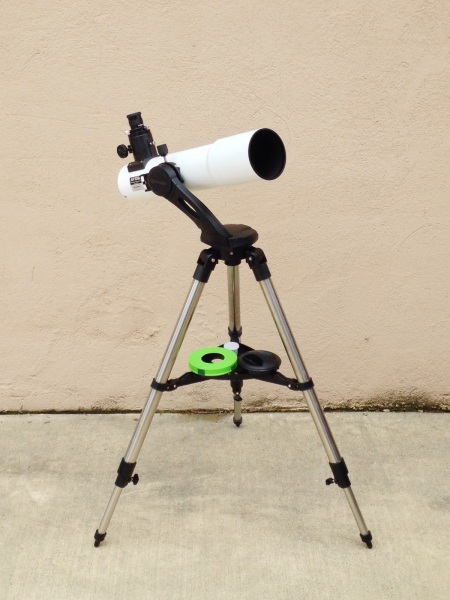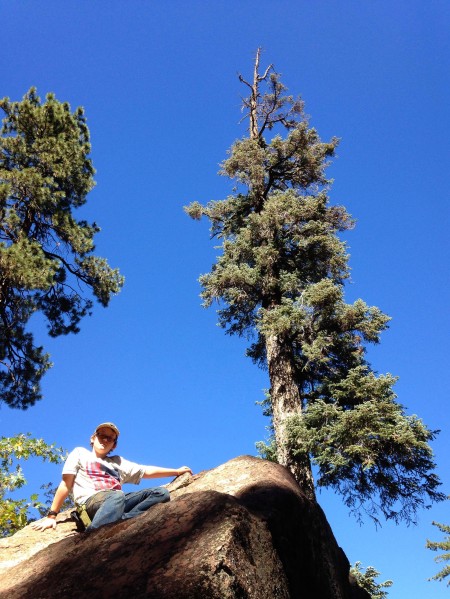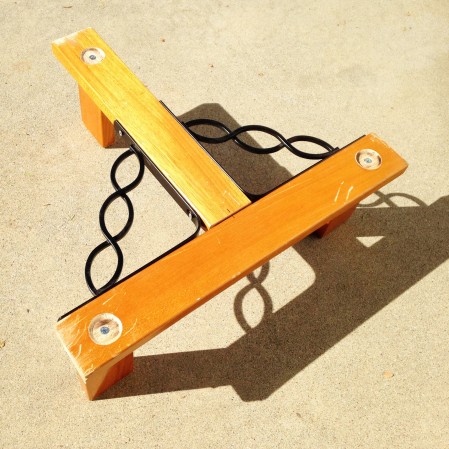
Here’s the Bresser Messier AR102S Comet Edition with a homemade aperture mask. I just converted the scope from a 102mm f/4.5 to a 60mm f/7.7.
“WAT!? You took a refractor, the most aperture-challenged of the three basic telescope designs, and made it even smaller?”
Yup. For several reasons.
The first and most obvious is to control chromatic aberration (CA), also known as false color. Despite the name ‘achromat’, which literally means ‘no color’, doublet refractors without extra-low dispersion (ED) glass do show some false color, because their lenses do not bring all of the colors of light to the same focus point (they’re still a LOT better than scopes with a singlet objective lens, like those used by Galileo). For dim objects like galaxies, nebulae, and most field stars, the effect is not noticeable, even in large and optically fast scopes like the AR102S Comet Edition (nickname needed). But bright objects like the moon, planets, and first magnitude stars will be surrounded by purplish halos, and may have yellowish margins. In effect, the purple and yellow-orange parts of the spectrum are forming out-of-focus images that are superimposed on the main in-focus image.
The problem is that CA gets bad fast as refractors get bigger. There are a couple of standards that are commonly used to describe the focal ratio necessary to minimize CA to acceptable levels, the Conrady standard and the Sidgwick standard. By the Conrady standard, the focal ratio must be 5 times the aperture in inches; by the less stringent Sidgwick standard, 3 times the aperture in inches is good enough. Note that the standards describe focal ratios, not focal lengths, so they go up fast with increasing aperture. Here are some apertures, focal ratios, and focal lengths required to meet the Sidgwick standard:
- 50mm (2″) : f/6 : 300mm
- 76mm (3″) : f/9 : 684mm
- 102mm (4″) : f/12 : 1224mm
- 127mm (5″) : f/15 : 1905mm
- 152mm (6″) : f/18 : 2736mm
This, along with mounting considerations, explains why reflectors and catadioptric scopes are progressively more common past 4″ in aperture. A 6″, f/8 Newtonian will be free of false color (as are all reflectors) and has such a gently converging light cone that it is easy to collimate and to focus – it’s easy for such scopes to achieve ‘planet-killer’ status if the mirror is good. A 6″, f/8 achromat will be a beast to mount and it will show lurid false color on bright objects.
But people still make, buy, and use such scopes! Why? Horses for courses: big, fast achromats can be superb deep-sky scopes, where chromatic aberration is typically not a problem. With the fixed sizes of standard eyepieces, achieving wide true fields requires short focal lengths (not just short focal ratios), and bright images require aperture, which drives the development of large but optically fast scopes like the AR102S Comet Edition. At f/4.5, it is well into ghastly CA territory on bright targets. The other night I stayed up late to catch Jupiter, and in the AR102S the planet wouldn’t even come to a clean focus. It was just a bright ball of light inside a sea of purple. I switched over to London’s 60mm f/11 Meade refractor and Jupiter snapped into a sharp and essentially color-free focus. There was a moon emerging from behind the limb of planet, already one moon-diameter out into black space, that was completely invisible in the CA-smudged view of the AR102S.
I’m okay with that – as I noted in a previous post, observing bright solar system targets with the AR102S is deliberate misuse of the scope. When I want good planetary views, I have a 5″ Mak and a 10″ Dob that can both be pushed to 500x (assuming the atmosphere is steady enough). But their max fields of view are pathetic compared to the AR102S – about 1.1 degrees for the Mak, and a shade over 2 degrees for the Dob, versus 3.6 degrees for the refractor, which is enough to take in all of Orion’s sword at once, with space left over on either side.
Still, I’m not going to take all of my scopes out with me every time I go observing, and chances are good that at some point I’ll want to look at something bright even if my main goal for the evening was low-power sweeping with the AR102S. Under those circumstances, it’s easier to have an aperture mask shoved in my eyepiece case than to pack a second scope. Hence this project and this post.
But I’m getting ahead of myself. There are other reasons to stop down a scope besides reducing CA:
- To reduce glare from bright objects. Mostly applies to the moon when it’s full or very gibbous.
- To give a more aesthetically pleasing image when the seeing is bad. Opinions differ on this point. Some folks prefer to look through a larger aperture despite the increased susceptibility to bad seeing, on the grounds that in the moments when the atmosphere does settle down a bit, you’ll see more detail. I suppose it depends on whether one is in exploration mode or aesthetic observation mode.
- To make it easier to focus. F/4.5 is a steep light cone, and it’s easy to overshoot the point of best focus. Stopping down the scope makes a shallower light cone, so it’s easier to watch the image transition from out of focus, to near focus, to in focus. I’m going to test this method of finding best focus on some close double stars.
I had done some calculations in advance to figure out what sizes of aperture masks I’d want to try out. Given that the AR102S has a fixed focal length of 459mm, here are the focal ratios at full aperture and at 10mm decrements:
- 102mm gives 459/102 = f/4.5
- 90mm gives 459/90 = f/5.1
- 80mm gives 459/80 = f/5.7
- 70mm gives 459/70 = f/6.5
- 60mm gives 459/60 = f/7.7
- 50mm gives 459/50 = f/9.2
- 40mm gives 459/40 = f/11.5

I didn’t want to trade away too much resolving power, so I tested the scope on the moon using cardboard masks of 76mm and 60mm, made from the light cardboard spacers from a box of wet cat food. The 76mm is shown above. Perhaps unsurprisingly, at this aperture and focal ratio (f/6) the view was still unappealingly soft. But 60mm looked good, with minimal CA. This makes sense – the working focal ratio of f/7.7 is a healthy step beyond the f/7.2 that the Sidgwick standard suggests for a 60mm aperture. Going any smaller would be trading away valuable resolution, without significantly improving the image.

The light cardboard aperture masks were fast and easy to make, but they weren’t very sturdy. To make a more permanent mask, I needed plastic, heavier cardboard, or foam-core board. So I unscrewed the dewshield from the scope and walked down to the dollar store, where I looked for food packages and storage containers that might fit. Finally on the last aisle I found this 1-gallon plastic jar. The lid slip-fit over the dewshield with just a bit of extra room, which I knew I could shim out with some sticky-back felt.

I wanted to make sure the lid would fit before I did the hard work of cutting, so I put the felt on first. This was very familiar – it seems like every other scope I get has a loose dust cover that has to be shimmed to fit correctly. I’ve been slowly chipping away at the same package of sticky-back felt since 2010. I didn’t have a compass handy, so I used a small paper ruler to make a ring of marks around concentric 60mm circle inside the lid. Then found a lid to a jar of vitamins that was exactly 60mm in diameter and used that to trace the circle neatly.

I was going to cut out the aperture using hobby knife, but the plastic was too tough. So I moved up to a box knife, and then a linoleum knife. Then I said heck with it and got the Dremel. The hole I cut wasn’t perfectly circular and had rough edges to boot, so I wrapped some sandpaper around a pill bottle to make a tool for rounding out the aperture.

Here’s the scope before…

…and after.
Even with the aperture mask, the AR102S is not a champion scope on solar system targets. The C80ED blows it away, which makes sense – it has a 33% resolution advantage over the stopped-down AR102S, and frankly just better glass. But at least the view now is clean and not appallingly degraded. A dramatic way to see the difference is to get a good tight focus on the moon with the mask on, then quickly take it off without removing one’s eye from the eyepiece, and watch the view get a lot brighter and a lot softer at the same time.
I have a few more things I want to do. The 60mm aperture mask fits over the end of the scope so securely that it could work as a dust cover, if only I can find or make something to plug the central hole. Also, I think I am going to play with making aperture masks in other sizes, just to see what happens.
And finally, I have another 4″ scope that will be fun to make an aperture mask for. But that will be a subject for another post.

.





















































